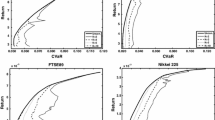Abstract
A mathematical model of portfolio optimization is usually quantified with mean-risk models offering a lucid form of two criteria with possible trade-off analysis. In the classical Markowitz model the risk is measured by a variance, thus resulting in a quadratic programming model. Following Sharpe’s work on linear approximation to the mean-variance model, many attempts have been made to linearize the portfolio optimization problem. There were introduced several alternative risk measures which are computationally attractive as (for discrete random variables) they result in solving linear programming (LP) problems. Typical LP computable risk measures, like the mean absolute deviation (MAD) or the Gini’s mean absolute difference (GMD) are symmetric with respect to the below-mean and over-mean performances. The paper shows how the measures can be further combined to extend their modeling capabilities with respect to enhancement of the below-mean downside risk aversion. The relations of the below-mean downside stochastic dominance are formally introduced and the corresponding techniques to enhance risk measures are derived.
The resulting mean-risk models generate efficient solutions with respect to second degree stochastic dominance, while at the same time preserving simplicity and LP computability of the original models. The models are tested on real-life historical data.
Similar content being viewed by others
References
W.J. Baumol, “An expected gain-confidence limit criterion for portfolio selection,” Management Science, vol. 10, pp. 174–182, 1964.
D.R. Carino, D.H. Myers, and W.T. Ziemba, “Concepts,technical issues and uses of the Russel-Yasuda Kasai financial planning model,” Operations Research, vol. 46, pp. 450–463, 1998.
E.J. Elton and M.J. Gruber, Modern Portfolio Theory and Investment Analysis (Third Edition), John Wiley & Sons, New York, 1987.
C.D. Feinstein and M.N. Thapa, “A Reformulation of a mean-absolute deviation portfolio optimization model,” Management Science, vol. 39, pp. 1552–1553, 1993.
P.C. Fishburn, “Mean-risk analysis with risk associated with below target returns,” American Economic Review, vol. 67, pp. 116–126, 1977.
P.C. Fishburn, “Stochastic dominance and moments of distributions,” Mathematics of Operations Research, vol. 5, pp. 94–100, 1980.
F. Glover and D. Klingman, “The simplex SON method for LP/embedded network problems,” Mathematical Programming Study, vol. 15, pp. 148–176, 1981.
H. Grootveld and W. Hallerbach, “Variance vs Downside Risk: Is There Really That Much Difference,” European Journal of Operational Research, vol. 114, pp. 304–319, 1999.
ILOG Inc., Using the CPLEX Callable Library, ILOG Inc., CPLEX Division, Incline Village, 1997.
H. Konno, “Piecewise linear risk function and portfolio optimization,” Journal of the Operations Research Society of Japan, vol. 33, pp. 139–156, 1990.
H. Konno and H. Yamazaki, “Mean-absolute deviation portfolio optimization model and its application to Tokyo stock market,” Management Science, vol. 37, pp. 519–531, 1991.
H. Konno and A. Wijayanayake, “Mean-absolute deviation portfolio optimization model under transaction costs,” Journal of the Operations Research Society of Japan, vol. 42, pp. 422–435, 1999.
H. Levy, “Stochastic dominance and expected utility: Survey and analysis,” Management Science, vol. 38, pp. 555–593, 1992.
R. Mansini and M.G. Speranza, “Heuristic algorithms for the portfolio selection problem with minimum transaction lots,” European Journal of Operational Research, vol. 114, pp. 219–233, 1999.
H.M. Markowitz, “Portfolio selection,” Journal of Finance, vol. 7, pp. 77–91, 1952.
H.M. Markowitz, Portfolio Selection: Efficient Diversification of Investments, John Wiley & Sons, New York, 1959.
W. Michalowski and W. Ogryczak, “Extending the MAD portfolio optimization model to incorporate downside risk aversion,” Naval Research Logistics, vol. 48, pp. 185–200, 2001.
W. Ogryczak and A. Ruszczyński, “From stochastic dominance to mean-risk models: Semideviations as risk measures,” European Journal of Operational Research, vol. 116, pp. 33–50, 1999.
W. Ogryczak and A. Ruszczyński, On Consistency of Stochastic Dominance and Mean–Semideviation Models. Mathematical Programming 89 (2001) 217–232.
W. Ogryczak and A. Ruszczyński, “Dual stochastic dominance and related mean-risk models,” SIAM J. Optimization, vol. 13, pp. 60–78, 2002.
W. Ogryczak and A. Ruszczyński, “Dual Stochastic Dominance and Quantile Risk Measures,” International Transactions in Operational Research, vol. 9, pp. 661–680, 2002.
M. Rothschild and J.E. Stiglitz, “Increasing risk: I. A definition,” Journal of Economic Theory, vol. 2, pp. 225–243, 1969.
A.D. Roy, “Safety-first and the holding of assets,” Econometrica, vol. 20, pp. 431–449, 1952.
H. Shalit and S. Yitzhaki, “Mean-Gini, Portfolio Theory, and the Pricing of Risky Assets,” Journal of Finance, vol. 39, pp. 1449–1468, 1984.
W.F. Sharpe, “A linear programming approximation for the general portfolio analysis problem,” Journal of Financial and Quantitative Analysis, vol. 6, pp. 1263–1275, 1971.
W.F. Sharpe, “Mean-absolute deviation characteristic lines for securities and portfolios,” Management Science, vol. 18, pp. B1–B13, 1971.
F.A. Sortino and H.J. Forsey, “On the use and misuse of downside risk,” Journal of Portfolio Management, pp. 35–42, Winter 1996.
M.G. Speranza, “Linear programming models for portfolio optimization,” Finance, vol. 14, pp. 107–123, 1993.
B.K. Stone, “A linear programming formulation of the general portfolio selection problem,” Journal of Financial and Quantitative Analysis, vol. 8, pp. 621–636, 1973.
G.A Whitmore and M.C. Findlay (Eds.), Stochastic Dominance: An Approach to Decision-Making Under Risk, D.C. Heath, Lexington MA, 1978.
Author information
Authors and Affiliations
Additional information
The research was supported by the grant PBZ-KBN-016/P03/99 from The State Committee for Scientific Research.
Rights and permissions
About this article
Cite this article
Krzemienowski, A., Ogryczak, W. On Extending the LP Computable Risk Measures to Account Downside Risk. Comput Optim Applic 32, 133–160 (2005). https://doi.org/10.1007/s10589-005-2057-4
Issue Date:
DOI: https://doi.org/10.1007/s10589-005-2057-4




